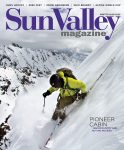Here in the West, hunting is less a diversion than a way of life; a seasonal pattern and rhythm—a way of being in the world.
Late season waterfowling, and the joy a hunter feels, amid such clemency of weather, reminds me of the passion experienced by the naturalist John Muir, who so often exalted to be high in the mountains, in any weather, or of the watercolor artist Walter Anderson, who would, when desiring rapture, lash himself to the tops of trees along the Mississippi Gulf Coast in advance of oncoming hurricanes, to be swept into the wildly uncontrollable flow of a great force—a force in which birth, growth, decay, death, and birth again were all tangled up at once: a force we call, in a kind of shorthand, life. ![]()
It’s been said, by philosophers and hunters such as Paul Shepherd, Doug Peacock, and others, that hunting is the organic act that has first and most shaped human intelligence. I believe this, and believe such genetic linkage—when and where it is still present—helps explain the seemingly mystical power and potency that hunting holds over those who practice it with respect and honor.

Such a hunter cannot travel out into the forest or the plains, the mountains or the marsh, observing each dawn’s rising of the world, and not marvel at the force that hand-selected every tiny working of the natural world, crafting meaning in every tiny breath and gesture. Looking at the iridescent hues of a bird’s wing in a certain angle of late-season sunlight, the hunter cannot help but pause, amid his or her sweating exertions or shivering labors, and, again, marvel.
What painted by hand—and continues to paint with such subtle adjustments, year by year, generation by generation—the world, and our place—each thing’s place, both the animate and the inanimate—in it?

In the autumn, and in the hunt, we are deep enough in that world to perceive that we somehow stand poised almost at the edge of being able to answer such a mystery.
I’ve been a hunter since my mid-teens, when I began hunting quail and doves with my parents in south Texas, which is where I grew up. Hunting in Texas meant then, and still means, for the most part, hunting on private property—the ranches of friends, or ranches leased for hunting. My mother and father and I would venture into the thorny thickets of mesquite and huisache in the autumn heat, hunting with shotguns behind whippet-thin English pointers with names like Buck and Sadie and Rip. >>>

Where I live now, and have lived for the last 20 years—in the low elevation mountains and rainforest off extreme northwestern Montana—I can travel on foot 20 miles or farther without crossing a single fence or even an active road, and in weather far more inclement, and exhilarating, than any I knew as a child.
When I am afield, I am able, in every glimpse, to marvel more fully at the incredible grace and sophistry of the world’s acutely integrated cycles. The journeys of the hunt provide for me a beautiful and always sensate reminder of our own place in these cycles, and, again, of our responsibility within it during our brief occupation of landscape and time.
Why then do I awaken before dawn, wade out into the frozen fall morning with a weapon and not a camera? For me, and those of us who are connected to the landscape and its natural processes, to deny that seemingly crude aspect of the entire process would then be a kind of extinguishment. The disowning, if you will, of a contract that was negotiated in us perhaps before we were born, or, at the latest, when we first entered a certain landscape.
I’ve thought about it a lot, and while I am convinced there is still in many of us that powerful genetic mandate to hunt and gather—a survival instinct, nurtured by the pleasure and passion for the mental and physical challenges, as well as the gastronomic prize, in hunting—I do believe that the call and urge to hunt might be even sharper for some of us.
 When I was younger, I embraced without hesitation that there were only two true defined seasons in the year: fall hunting season, and then all the rest of the year. As any hunter knows, it is the anticipation—particularly in the crepuscular hours—that is as much at the heart of the hunt as anything.
When I was younger, I embraced without hesitation that there were only two true defined seasons in the year: fall hunting season, and then all the rest of the year. As any hunter knows, it is the anticipation—particularly in the crepuscular hours—that is as much at the heart of the hunt as anything.
Rarely do I consider any of us yet fitted all that gracefully to this dynamic and vibrant larger world, which we so often perceive we dominate, but which we do not dominate and cannot control in the least. Surely, more than anything else, we as a species are a work-in-progress, trying (but sometimes not very hard) to adjust the hitch in our gait and stride to meet that of this dynamic world’s, and the seasons. And it is in hunting season that I most feel fitted and capable of meeting that biological challenge, and this awesome opportunity for, and awesome responsibility to, life.
Again, I’m grateful to have a place, an identity, and a way-of-being, that allows me the chance to more fully fit myself into the natural world’s—particularly the world of our wilder backcountry—processes and patterns.
The attentiveness and respectfulness in many hunters’ relationships to both their quarry and the shared landscape could be said perhaps to approach that of prayer.

